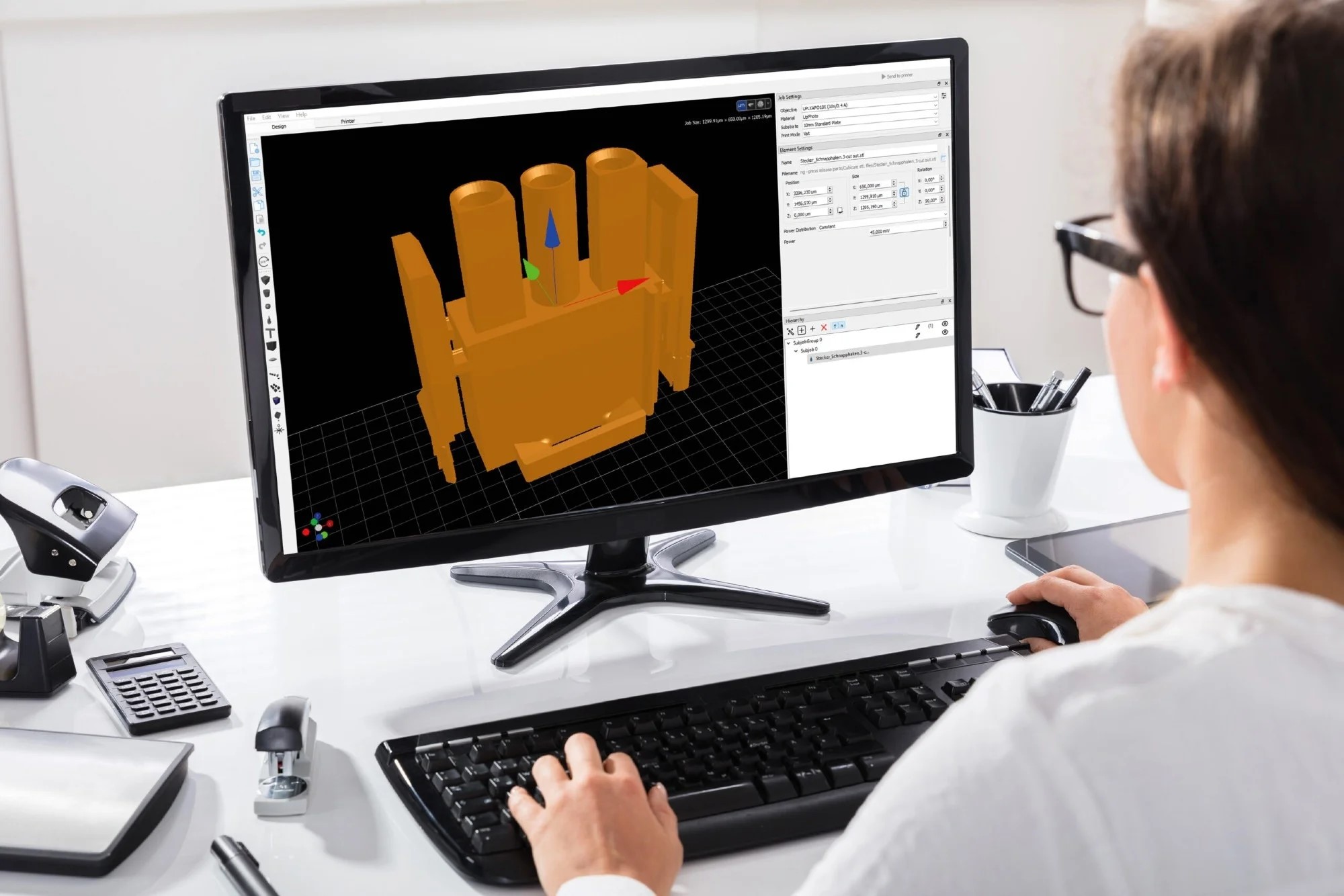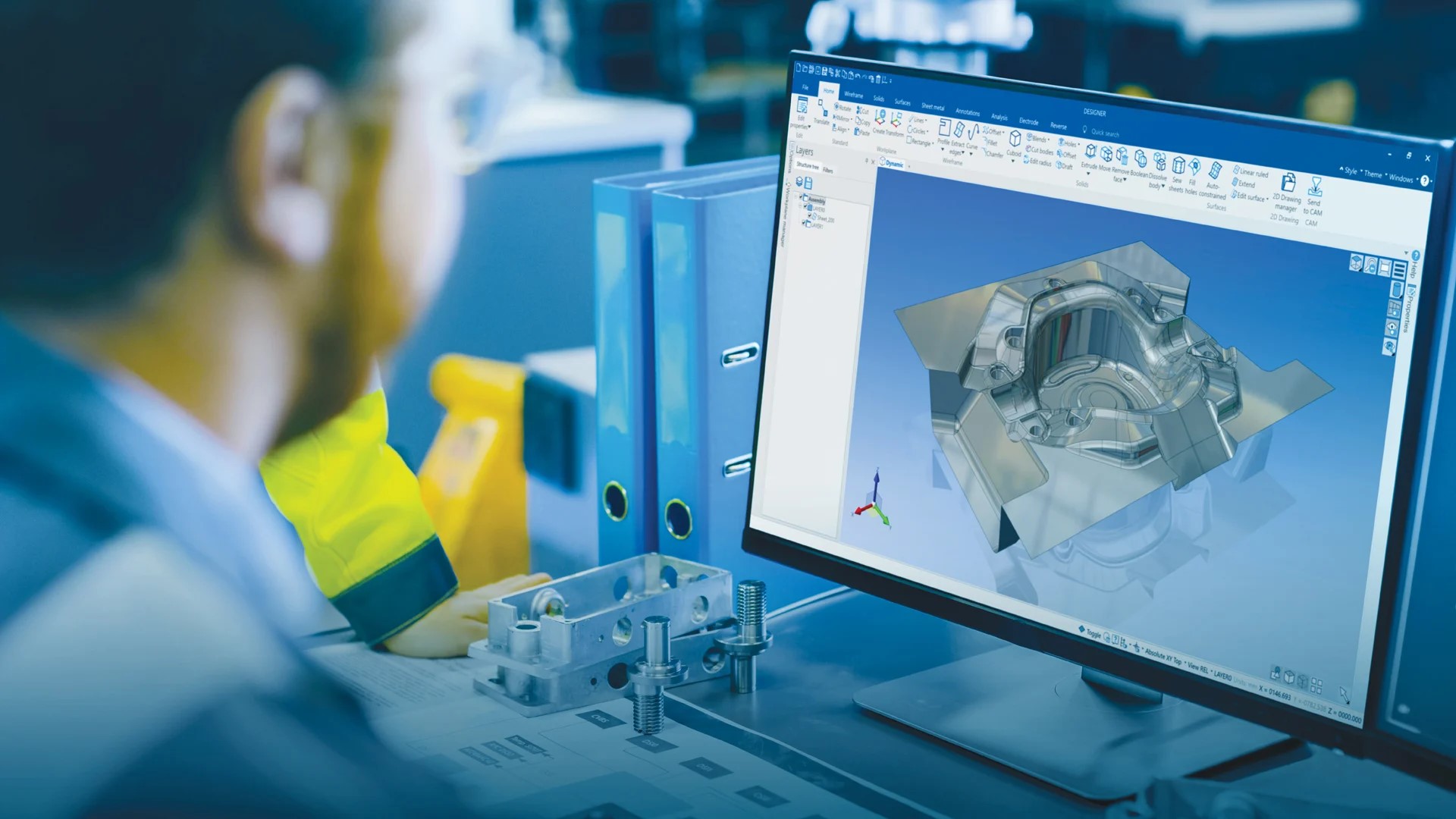Home>diy>Architecture & Design>Why Is CAD An Important Part Of Agriculture Mechanics And Engineering


Architecture & Design
Why Is CAD An Important Part Of Agriculture Mechanics And Engineering
Modified: January 9, 2024
Discover the significance of CAD in agriculture mechanics and engineering. Explore how architecture design plays a vital role in shaping advancements
(Many of the links in this article redirect to a specific reviewed product. Your purchase of these products through affiliate links helps to generate commission for Storables.com, at no extra cost. Learn more)
Introduction
In today’s rapidly evolving world, the integration of technology into various industries has become essential for growth and efficiency. This includes the field of agriculture, where traditional farming methods are being revolutionized by the adoption of advanced technological solutions. One such solution that has gained significant importance in agriculture mechanics and engineering is Computer-Aided Design, commonly known as CAD.
CAD encompasses a range of software tools and technologies that enable engineers and designers to create, modify, and optimize detailed 2D and 3D models of agricultural machinery, structures, and processes. By utilizing CAD, professionals in the field can enhance their design capabilities, streamline production processes, and improve overall efficiency in agricultural operations.
Over the years, CAD has become an integral part of agriculture mechanics and engineering, playing a pivotal role in the development of innovative and sustainable farming practices. This article delves into the definitions, the role, benefits, challenges, case studies, and future trends of CAD in agriculture mechanics and engineering.
So, let’s dive deeper into the world of CAD and understand why it is such an important part of agriculture mechanics and engineering.
Key Takeaways:
- CAD revolutionizes agriculture by enhancing design, visualization, and collaboration, leading to improved efficiency and sustainable farming practices.
- Future trends in CAD, such as AI integration and VR/AR visualization, promise to further enhance agricultural systems, driving innovation and productivity in the industry.
Read more: How Is CAD Used In Engineering
Definition of CAD in Agriculture Mechanics and Engineering
Computer-Aided Design (CAD) is a software technology that enables engineers, designers, and architects to create, modify, and optimize detailed digital representations of physical objects and systems. In the context of agriculture mechanics and engineering, CAD is a powerful tool that allows professionals to design and visualize agricultural machinery, equipment, structures, and processes.
The CAD software applications provide a user-friendly interface where engineers can draft 2D or 3D models of their designs. These models can be created from scratch or imported from existing designs. CAD enables precise measurements, accurate scaling, and easy modification of designs, reducing the chances of errors and allowing for faster iterations.
With CAD, agricultural engineers can create designs for various components such as tractors, harvesters, irrigation systems, greenhouses, storage facilities, and more. Additionally, CAD allows for the integration of computational analysis tools, such as finite element analysis, to assess the structural integrity and performance of the designed components or systems.
CAD software also supports the generation of detailed technical drawings, engineering documentation, and production specifications. This enhances communication between different teams involved in the agriculture mechanics and engineering process, ensuring a smooth collaboration and facilitating the manufacturing and assembly of the designed components.
Overall, CAD in agriculture mechanics and engineering provides a digital platform where professionals can visualize and optimize their designs, leading to more efficient and cost-effective agricultural systems.
The Role of CAD in Agriculture Mechanics and Engineering
CAD plays a crucial role in agriculture mechanics and engineering, transforming the way professionals conceptualize, design, and implement solutions for the agricultural industry. Here are some key roles that CAD fulfills in this field:
- Design and Visualization: CAD enables engineers and designers to create detailed 2D and 3D models of agricultural machinery, equipment, and structures. This allows them to visualize their designs and identify potential issues or areas for improvement before the physical implementation. By providing a realistic representation, CAD helps in making informed design decisions and ensuring the optimal functionality and efficiency of agricultural systems.
- Optimization and Iteration: CAD software provides tools for analyzing, simulating, and optimizing designs. Agricultural engineers can test different scenarios, evaluate the performance of various components, and make necessary modifications to improve efficiency and productivity. This iterative process enables engineers to fine-tune their designs to achieve the desired outcomes while reducing costs and potential risks.
- Collaboration and Communication: CAD software facilitates effective communication and collaboration among stakeholders involved in the agriculture mechanics and engineering process. Engineers, designers, manufacturers, and farmers can easily share and exchange design files, technical drawings, and documentation. This seamless collaboration ensures a better understanding of requirements, reduces errors, and streamlines the overall workflow.
- Integration with Manufacturing Processes: CAD designs can be seamlessly integrated with manufacturing processes such as Computer Numerical Control (CNC) machining, 3D printing, and robotic assembly. This ensures accurate and efficient production of agricultural components, reducing manufacturing lead times and costs. CAD enables the generation of production-ready specifications and instructions, eliminating the need for manual measurement and conversion of design data.
- Data-Driven Decision Making: CAD software allows for the collection and analysis of data during the design process. This data-driven approach helps engineers make informed decisions based on accurate measurements, performance simulations, and real-time feedback. By leveraging CAD’s capabilities, agricultural professionals can adopt a more systematic and evidence-based approach, leading to better outcomes and increased productivity.
In summary, CAD plays a pivotal role in agriculture mechanics and engineering by enabling efficient design and visualization, optimization and iteration, collaboration and communication, integration with manufacturing processes, and data-driven decision making. These roles contribute to the development of innovative and sustainable agricultural systems, improving productivity and addressing the challenges faced by the industry.
Benefits of Using CAD in Agriculture Mechanics and Engineering
The use of CAD in agriculture mechanics and engineering brings forth a multitude of benefits that contribute to the advancement and efficiency of agricultural systems. Here are some key advantages of utilizing CAD in this field:
- Improved Design Accuracy: CAD software ensures precise measurements, accurate scaling, and the ability to create complex geometries. This leads to designs that are more accurate and aligned with the intended specifications, reducing the chances of errors and rework during the manufacturing and implementation phases.
- Increased Design Efficiency: CAD tools provide a range of features and functionalities that accelerate the design process. Templates, libraries, and parametric modeling capabilities allow designers to create designs faster and with greater consistency. This efficiency boost enables engineers to focus on innovation and problem-solving rather than tedious manual drafting.
- Enhanced Visualization and Communication: CAD offers visual representation of designs through 2D and 3D models, making it easier for stakeholders to understand and provide feedback. These visualizations help bridge the gap between engineers, manufacturers, and end-users, facilitating effective communication and reducing misunderstandings.
- Cost and Time Savings: CAD enables engineers to identify and resolve design issues before the physical implementation, resulting in cost savings from avoiding costly rework and modifications. Additionally, CAD integrates with manufacturing processes, automating tasks and reducing production lead times, thus increasing overall efficiency.
- Accuracy in Component Integration: CAD allows for accurate integration of various components in agricultural machinery and structures, ensuring compatibility and functionality. It enables engineers to simulate the assembly process and identify any interferences or clashes before actual construction, saving time and resources.
- Simulation and Optimization: CAD software provides simulation tools that enable engineers to test the performance and behavior of agricultural systems. This allows for optimization of designs, identifying areas for improvement in terms of efficiency, functionality, and resilience. By running simulations, engineers can make informed decisions to optimize performance and reduce risks.
- Sustainability and Environmental Considerations: CAD tools help in designing environmentally friendly and sustainable agricultural practices. The ability to analyze energy consumption, material usage, and environmental impacts allows engineers to optimize designs to minimize negative effects on ecosystems and natural resources.
- Long-Term Maintenance and Management: CAD software assists in the management of agricultural systems by providing accurate documentation, technical drawings, and specifications. This ensures that maintenance, repairs, or replacements can be efficiently carried out, extending the lifespan of agricultural machinery and structures.
The utilization of CAD in agriculture mechanics and engineering not only enhances the design process but also leads to improved productivity, cost savings, sustainability, and overall efficiency in the agricultural industry.
CAD (Computer-Aided Design) is important in agriculture mechanics and engineering as it allows for precise and efficient design of equipment, structures, and systems, leading to improved productivity and cost-effectiveness in the agricultural industry.
Challenges and Limitations of CAD in Agriculture Mechanics and Engineering
While Computer-Aided Design (CAD) offers numerous benefits in agriculture mechanics and engineering, there are also certain challenges and limitations that need to be considered. These include:
- Initial Investment and Training: Implementing CAD software requires a significant initial investment in terms of software licenses and hardware requirements. Additionally, proper training and upskilling of engineers and designers are necessary to effectively utilize the software’s capabilities. The cost and time associated with these investments can be a barrier for small-scale agricultural operations.
- Data Compatibility and Integration: CAD software compatibility with other systems, such as manufacturing machinery or data exchange formats, can be a challenge in agricultural settings. Integration issues may arise when exchanging design files or ensuring compatibility with production equipment, potentially leading to disruptions in the manufacturing process.
- Complexity and Learning Curve: CAD software can be complex to use, requiring a steep learning curve for individuals new to the technology. Designers and engineers may need time to become proficient in utilizing the various tools and functionalities offered by the software. This learning curve can impact productivity during the initial stages of implementation.
- Limited Field-Specific Features: While CAD software provides a wide range of design and modeling capabilities, it may lack domain-specific features tailored specifically for agriculture mechanics and engineering. This limitation can make it challenging for professionals to address industry-specific requirements, leading to workarounds or manual adjustments to achieve desired outcomes.
- Data Security and Intellectual Property: CAD software stores designs and intellectual property digitally, posing potential risks of unauthorized access or data breaches. Protecting sensitive design information from theft or misuse is crucial, especially when collaborating with external vendors or manufacturers.
- Dependency on Hardware and Software Updates: CAD software is dependent on the performance and compatibility of hardware systems. As technology advances, software updates may require upgrades to hardware components to ensure optimal performance. These upgrades can incur additional costs for maintaining and supporting CAD systems.
- Limitations in Physical Representation: CAD software relies on digital representations of agricultural systems. While these models provide useful insights, they may not fully capture the real-world physical behavior of machinery or equipment. Factors such as environmental conditions, soil variations, or machinery limitations may not be accurately represented, requiring additional field testing or adjustments during physical implementation.
It is important for agricultural professionals to be aware of these challenges and limitations while implementing CAD in their operations. By understanding and proactively addressing these issues, the full potential of CAD can be realized, leading to enhanced productivity and innovation in the agriculture mechanics and engineering field.
Read more: How To Import CAD Into Revit
Case Studies: Successful Implementation of CAD in Agriculture Mechanics and Engineering
Several case studies showcase the successful implementation of Computer-Aided Design (CAD) in agriculture mechanics and engineering, demonstrating the tangible benefits it brings to the industry. Here are a few examples:
- Case Study 1: Precision Farming Equipment Design
- Case Study 2: Greenhouse Structural Design
- Case Study 3: Agricultural Drone Design
- Case Study 4: Robotic Harvesting System
A leading agricultural machinery manufacturer leveraged CAD to design precision farming equipment. By utilizing CAD software, they were able to create sophisticated 3D models of their machinery, enabling them to optimize the placement of sensors, adjust soil management systems, and fine-tune the application of fertilizers and pesticides. This improved accuracy and efficiency in farming operations, leading to increased crop yields and reduced input costs.
In the development of a modern greenhouse, CAD was instrumental in the design process. By using CAD software, engineers were able to create detailed 3D models of the greenhouse structure, incorporating factors such as ventilation, lighting, and temperature control systems. The use of CAD allowed them to simulate and optimize the design, ensuring maximum energy efficiency, optimal plant growth conditions, and reduced environmental impact.
A drone company specializing in agricultural applications utilized CAD to design and prototype agricultural drones. By employing CAD software, they were able to create intricate 3D models of the drone and its components, including the payload system and flight control mechanisms. CAD allowed them to iterate and refine designs, resulting in drones that could accurately monitor crop health, apply targeted treatments, and collect valuable data for precision agriculture.
In the development of a robotic harvesting system for large-scale agricultural operations, CAD played a vital role. By employing CAD software, engineers were able to design the robotic arm, grippers, and motion control systems. CAD allowed them to simulate and optimize the robotic system’s movements and coordination, ensuring efficient and precise harvesting. The use of CAD ultimately led to increased productivity, reduced labor costs, and minimized crop damage.
These case studies demonstrate how CAD has revolutionized the agriculture mechanics and engineering industry, enabling the design and optimization of innovative solutions for improved productivity, sustainability, and cost-efficiency.
Future Trends and Innovations in CAD for Agriculture Mechanics and Engineering
The field of agriculture mechanics and engineering is continuously evolving, and the future of Computer-Aided Design (CAD) holds several exciting trends and innovations that will further enhance agricultural systems and practices. Here are some key trends to watch out for:
- Integration of Artificial Intelligence (AI): AI technologies can be integrated into CAD software to automate repetitive tasks and enhance design optimization. AI algorithms can analyze large datasets to predict optimal design configurations, improve energy efficiency, and optimize resource allocation in agriculture mechanics and engineering.
- Virtual and Augmented Reality (VR/AR) Visualization: VR and AR technologies are being increasingly used to provide immersive visualization experiences in CAD software. This allows designers and engineers to explore and interact with their designs in a virtual environment, enabling better understanding, collaboration, and design validation.
- Internet of Things (IoT) Integration: CAD software is likely to integrate with IoT devices and sensors for real-time data collection, enabling dynamic design modifications and performance monitoring. This integration can optimize the functionality of agricultural machinery, manage maintenance schedules, and enhance overall system efficiency.
- Generative Design: CAD software is starting to incorporate generative design techniques, where algorithms can create multiple design iterations based on specified criteria and constraints. Generative design enables engineers to explore innovative and optimized design solutions that may not have been considered through traditional design methods.
- Bio-inspired Design: CAD will increasingly take inspiration from natural systems and biological processes to design sustainable and efficient agricultural solutions. By analyzing and emulating natural structures and systems, engineers can develop designs that are better adapted to the environment, improving resilience and resource utilization.
- Cloud-Based Collaboration: The future holds increased cloud-based collaboration in CAD for agriculture mechanics and engineering. This enables real-time collaboration between geographically dispersed teams, seamless sharing of design files, and access to software and computing resources, fostering global innovation and maximizing efficiency.
- Simultaneous Multi-Disciplinary Collaboration: CAD software is evolving to facilitate simultaneous collaboration between different disciplines involved in agriculture mechanics and engineering, such as engineers, agronomists, and biologists. This enables a holistic approach to design, considering factors like soil health, crop management, and environmental impact, leading to more integrated and sustainable agricultural systems.
These future trends and innovations in CAD for agriculture mechanics and engineering will pave the way for advanced and sustainable farming practices, improving productivity, resource utilization, and environmental sustainability. Keeping up with these advancements will be crucial in staying at the forefront of the industry.
Conclusion
The integration of Computer-Aided Design (CAD) in agriculture mechanics and engineering has significantly transformed the agricultural industry, enabling professionals to design, optimize, and implement innovative solutions. CAD has become an indispensable tool for designing precision farming equipment, developing efficient greenhouse structures, creating agricultural drones, and designing robotic systems for harvesting.
The advantages of CAD in agriculture mechanics and engineering are wide-ranging. It improves design accuracy, enhances visualization and communication, saves costs and time through simulation and optimization, and enables seamless integration with manufacturing processes. CAD also contributes to sustainable agricultural practices by considering environmental factors and optimizing resource utilization.
While there are challenges and limitations to overcome, such as initial investments, data compatibility, and complexity, the benefits of CAD outweigh the drawbacks. Moreover, future trends and innovations in CAD, such as AI integration, VR/AR visualization, and generative design, promise to further enhance agricultural practices and systems.
It is vital for professionals in agriculture mechanics and engineering to stay abreast of these advancements and continuously upskill themselves to leverage the full potential of CAD. By embracing CAD technology and incorporating it into their workflow, professionals can drive significant improvements in productivity, efficiency, and sustainability in the agricultural industry.
In conclusion, CAD is the key to unlocking innovation in agriculture mechanics and engineering. With its continuous evolution and integration of advanced technologies, CAD is poised to revolutionize the industry and pave the way for a more efficient, sustainable, and productive future in agriculture.
Frequently Asked Questions about Why Is CAD An Important Part Of Agriculture Mechanics And Engineering
Was this page helpful?
At Storables.com, we guarantee accurate and reliable information. Our content, validated by Expert Board Contributors, is crafted following stringent Editorial Policies. We're committed to providing you with well-researched, expert-backed insights for all your informational needs.















0 thoughts on “Why Is CAD An Important Part Of Agriculture Mechanics And Engineering”